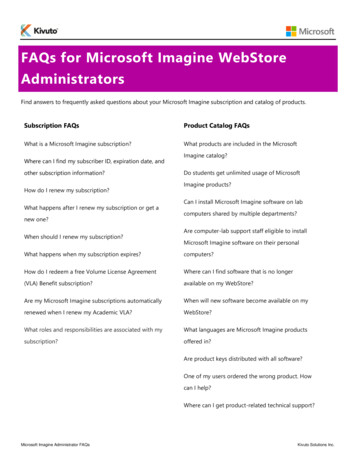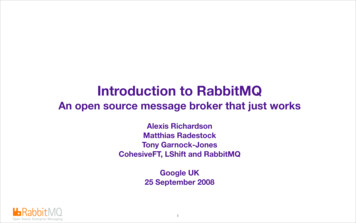
Transcription
Packet #3Imagine you are working on a research paper about digital identity and issueswith online privacy. Read the three information sources that follow this page andkeep the CAARP model in mind as you review each source.Remember:C CurrencyA AuthorityA AccuracyR RelevanceP PurposeFor the third and final source you will see the address (URL) of a website. Click onthat link to be taken to a website. Please review the website as a whole for yourthird and final source.To complete your assignment, goto: http://library.uncw.edu/instruction/UNI library assignment. Login at thebottom of the page and follow the directions to answer questions about eachinformation source.
Source #1information security technical report 13 (2008) 71–75available at tions/prodinf.htmIdentity management of e-ID, privacy and securityin Europe. A human rights viewPaul De Herta,baLaw Science Technology & Society (LSTS), Department of Metajuridica, Faculty of Law, Vrije Universiteit Brussel, Brussels, BelgiumTilburg Institute for Law, Technology and Society, University of Tilburg, NetherlandsbabstractWith privacy enhancing identity management, end users are given better ways formanaging their identities for specific contexts. One could easily argue that the need toimplement identity management systems that are privacy enhancing follows from theEU data protection regulation. One of the challenges while developing privacy enhancingidentity management is getting governments to become genuinely interested, both in theircapacity of data processing organisation and legislator or policy maker. Another challenge,this time for the private sector, is to find the right balance between data protection perfection and simplicity or users’ convenience, while developing privacy enhancing identitymanagement systems. After a brief discussion of these challenges we discuss the growinghuman rights recognition of the value of digital identity and its management. In particular,the German constitutional court seems to pave the way for a basic right to have digitalidentity protected and secured.ª 2008 Elsevier Ltd. All rights reserved.1.GeneralPrivacy is generally associated with the protection of theintegrity, autonomy and private life of the individual. Basically, it’s about people’s right to choose how they want tolive their life, and what things they want to keep private. Dowe have a choice when interacting online? Often we do. Theemergence of the Internet has allowed more and more peopleto discover certain aspects of identity formation hithertounknown. Online worlds let you create a character, a homeand a new personality if you wish. Often we do not. In orderto obtain certain goods or services we are required to identifyourselves in ways beyond our control.Identity management (IDM) is commonly referred to as theset of processes and tools that serve to establish the identity ofa user (e.g. enrol an employee, customer, contractor) ina system.1 Today a trend towards user-centricity and privacyenhancing identity management is noticeable,2 with the EUfunding research initiatives such as Prime enabling moreuser control.3 User-centricity distinguishes itself from otherE-mail address: paul.de.hert@uvt.nlA. Carblanc, ‘Digitial identity and its management in e-society’, paper presented at NATO Advanced Research Workshop (ARW) onIdentity, Security And Democracy; Social, Ethical and Policy Implications of Automated Systems for Human Identification (Ait) organisedby the Centre for Science, Society and Citizenship and the Israeli Center for the Study of Bioterrorism in Jerusalem, September 2–4, 2006(9p.), p. 3.2S. Clauss and others, ‘Privacy-Enhancing Identity Management’, IPTS reports, 2002, vol. 67 l67/IPT2E676.htm).3Jan Camenisch and others, ‘Privacy and identity management for everyone,’ ACM, 2005, p. 20–27. For a more comprehensive oversight, see Martin Meints & Marit Hansen, ‘Identität – die europäische Perspektive. Übersicht über aktuelle EU-Projekte’, DuD – Datenschutzund Datensicherheit, vol. 30 (2006) Issue 9, p. 531–532.1363-4127/ – see front matter ª 2008 Elsevier Ltd. All rights reserved.doi:10.1016/j.istr.2008.07.0011
72information security technical report 13 (2008) 71–75notions of IDM by emphasising that the user (or some agent ofthe user) – and not some authority – maintains control over‘‘what, where, when, and to whom’’ a user’s identity information is released.4 The researchers gathered in Prime to developidentity management systems that give individuals sovereignty over their personal data so that: (1) individuals can limitthe information collected about them by using pseudoidentities, certifications and cryptography when performingonline transactions; (2). individuals can negotiate legallybinding ‘‘privacy policies’’ with their service providers whichgovern how disclosed personal data can be used and whichprecautions must be taken to safeguard it, and (3) individualsand service providers can use automated mechanisms tomanage their personal data and their obligations towardsdata which they have collected from other parties.5The proposed system includes an anonymous credentialsystem, an access control system based on a novel paradigm,a negotiation functionality, and an automated reasoningsystem. ‘‘This machinery performs most of the decisionmaking involved in privacy management and involves theuser mainly for making final high-level decisions and forgiving consent to data processing. Together, these components give a user the power to easily manage her privacywithout being an expert in the field’’.62.There is no question about the ability of identity management systems to support the realisation of data protectionrights and goals geared towards giving a person notice,consent, security, and access with respect to his personaldata. In identity management systems it is, for example, technically possible for parties to provide the type of notice andnegotiate the kind of consent envisioned in the principle ofpurpose limitation. Similarly, identity management systemscan include mechanisms to provide users with security asspelled out in the principles of security and to enable a personto know how data is treated and contest that treatment, asforeseen by the principles of rights of access, rectificationand opposition.7The legal frameworkWith privacy enhancing identity management, end users aregiven better ways for managing their identities for specificcontexts. One could easily argue that the need to implementidentity management systems that are privacy enhancingfollows from the EU data protection regulation, in particularEU Directives 95/46/EC and 2002/58/EC (whose purposes areto safeguard individuals’ privacy and freedom) and from theEU 2000 Charter on Fundamental Rights. These sets of regulations impose a number of important principles:(1) the purpose limitation principle – data should be processedfor a specific purpose and subsequently used or furthercommunicated only insofar as this is not incompatiblewith the purpose of the transfer;(2) the data quality and proportionality principle – data shouldbe accurate and, where necessary, kept up to date. Thedata should be adequate, relevant and not excessive inrelation to the purposes for which they are transferred orfurther processed;(3) the transparency principle – individuals should beprovided with information as to the purpose of the processing and the identity of the data controller in the thirdcountry, and other information insofar as this is necessaryto ensure fairness;4(4) the security principle – technical and organisational security measures should be taken by the data controller thatare appropriate to the risks presented by the processing.Any person acting under the authority of the datacontroller, including a processor, must not process dataexcept on instructions from the controller;(5) the rights of access, rectification and opposition – the datasubject should have a right to obtain a copy of all datarelating to him/her that are processed, and a right to rectification of those data where they are shown to be inaccurate. In certain situations he/she should also be able toobject to the processing of the data relating to him/her.Mary Rundle and others, ‘At a Crossroads: ‘‘Personhood’’ andDigital Identity in the Information Society’, STI Working Paper2007/7, OECD, February 2008 (52p.), p. 22 Jan Camenisch and others, ‘Privacy and identity managementfor everyone’, ACM, 2005, p. 20.6Jan Camenisch and others, ‘Privacy and identity managementfor everyone’, ACM, 2005, p. 20.3.Problems with privacy enhancing identitymanagement: public sectorOne of the challenges while developing privacy enhancingidentity management is getting governments to becomegenuinely interested, both in their capacity of data processing organisation and legislator or policy maker. Governments have traditionally had a central role in providing forthe identity of citizens through the issuance of documentssuch as birth and death certificates, passports, social security numbers or driving licences. Today they need to be concerned over respect for privacy, data protection and securityand respond to challenges posed by digital identity management by setting up frameworks that are beneficial to usercontrol over e-Identity aspects. The OECD has elaboratedguidelines to improve a culture of security between all thestakeholders involved in the exchange of information andto encourage sound security practices.8 The EU launcheda Safer Internet Action Plan,9 and both at the level of theCouncil of Europe and at the level of the EU measureswere adopted obliging Member States to incriminate certaincrimes related to digital identity and to collaborate in cases7Mary Rundle and others, ‘At a Crossroads’, p. 33. Mary Rundleand others, ‘At a Crossroads’, p. 28–32.8OECD, OECD Guidelines for the Security of Information Systems andNetworks: Towards a Culture of Security (adopted as a Recommendation of the OECD Council at its 1037th Session on 25 July 2002),Paris, OECD, 29p 9Seehttp://ec.europa.eu/information society/activities/sip/index en.htm.
information security technical report 13 (2008) 71–75with an international dimension.10 The EU 2002 Directive onPrivacy and Electronic Communications requires that location information generated by mobile phones can only befurther used or passed on by network operators with prioruser consent, unless it is an emergency call. In a recentreport commissioned by the OECD examples are forwardedof user-centric and privacy enhancing approaches tonational identity card schemes.11 In the future the Belgiume-Identity card will allow persons to prove that they areolder than 18 without being required or forced to makepublic other data.12A 2003 European report showed with regard to identitytheft in Europe that, due to strong existing European legislation, which defines clear privacy and data protection rights,this type of crime is less frequent than in other countries.13Clearly, our policy makers are not absent. However, somegovernments are setting up very simple, centralised identitymanagement systems using unique identifiers ignoring risksand security risks.14 Currently all European Member Statesare setting up centralised or semi-centralised fingerprintdatabases of citizens, largely ignoring the sloppy, insecureuse of fingerprint biometrics in the private sector.15 In June2007 Dutch scientists have discovered that a certain type ofsmartcard, Mifare, which is used to gain access to governmentdepartments, schools and hospitals around Britain, is carryinga serious security flaw that allows it to be easily copied.16Earlier this year a major smartcard system with similar goalsin the Netherlands was easily compromised by the sameinvestigators.17The government is also responsible for national securityand criminal law enforcement. The law acknowledges this10P. De Hert, G. González Fuster & E.-J. Koops, ‘Fighting cybercrime in the two Europes: the added value of the EU FrameworkDecision and the Council of Europe Convention’, InternationalReview of Penal Law, vol. 77, 2006, No. 3–4, 503–524.11Mary Rundle and others, ‘At a Crossroads’, p. 36.12See ‘Algemeen EID Officieel antwoord van KUL onderzoeksgroep op artikel en studie Persbericht – De Elektronische Identiteitskaart is Veilig’, COSIC, K.U. Leuven, 13 June 2008 icieel-antwoord-vankul-onderzoeksgroe).13B. Clements, I. Maghiros, L. Beslay, C. Centeno, Y. Punie, C.Rodrı̈guez & M. Masera (eds.), Security and Privacy for the Citizenin the Post-September 11 Digital Age. A prospective overview, Reportto the European Parliament Committee on Citizens’ Freedomsand Rights, Justice and Home Affairs (LIBE), July 2003, Brussels,European Commission, IPTS-Technical Report Series, EUR 20823EN, 188p. (http://ftp.jrc.es/EURdoc/eur20823en.pdf).14A. Carblanc, ‘Digitial identity and its management ine-society’, p. 3.15P. De Hert, ‘Legal Aspects of Biometric Technologies’, inInstitute For Prospective Technological Studies – JointResearch Centre, Biometrics at the Frontiers: Assessing the Impacton Society, Report to the European Parliament Committee onCitizens’ Freedoms and Rights, Justice and Home Affairs(LIBE), February 2005, IPTS-Technical Report Series, EUR21585 EN, p. 75–85.16Miller, Vikki, ‘‘Oyster card: fears over Mifare security’’, The Telegraph, 21 June 2008. tml.17‘OV-chip 2.0. Dutch develop open source smart card for publictransport’, Amsterdam, June 19, 2008, nd allows, for example, use of data without consent for thesepurposes.18However, on response to the threat of terrorism after thetragedy of September 11, many governments enhanced theirsurveillance powers, voting laws that were heavily criticisedfrom a privacy perspective. The EU seemingly takes part inthe global tendency towards ambient intelligence securityenforcement scenarios, relying on the massive collectionand processing of (personal and non personal) data in combination with data mining and profiling techniques. Thistendency highlights the fragility of data protection law asa tool to control surveillance. Lawful collection and processingof personal data does not prevent per se unethical practicesdeployed in the name of security, or unjust decisions basedon them. Arguably, the alleged need ‘to mobilize informationto prevent terrorism’19 and equivalent instructions frontallycontradict fundamental principles of data protection law(such as the minimisation principle) and the requirementsfor privacy enhancing identity management.20 A generalframework to limit surveillance needs to be designed, inwhich the enabling force of data protection regulation is complemented with more clearly defined restrictive principles.4.Problems with privacy enhancing identitymanagement: private sectorTurning to the private sector we see a major challenge infinding the right balance between data protection perfectionand simplicity or users’ convenience, while developingprivacy enhancing identity management systems. Withoutthis balance users will consent to schemes that are simplebut erode privacy concerns.In a 2008 OECD report these and other risks are amplyidentified.21 The report insists on the following technical qualities that users are implicitly demanding for the privacyaspects of user control: decentralisation (maximal decentralisation of identity information into as many separate datacontexts as possible); data minimisation and selective disclosure; use of local identifiers (avoid using more global identifiers such as a government tax identity number); verifiability(the system must support mechanisms for verification ofclaims), and composability. Even more important in the reportis the suggestion to rewrite five data protection principles18Article 13 of the EU 1995 Directive contains exceptions withregard to the purpose limitation principle, the transparency principle and the principle of access.19See, for instance: Markle Foundation Task Force (2006), Mobilizing Information to Prevent Terrorism: Accelerating Development ofa Trusted Information Sharing Environment, Third Report, July.20F. González Fuster, S. Gutwirth & P. De Hert, ‘The Role of Law,Ethics and Justice in Security Practices’ in J. Peter Burgess & DavidRodin (eds.), The Role of Law, Ethics and Justice in Security PracticesConference report, Oslo, International Peace Research Institute(PRIO), 2008 (69p.), 22–24 (http://www.prio.no). On the risk ofdestruction of personhood, see Mary Rundle and others, ‘Ata Crossroads’, p. 21.21Mary Rundle and others, ‘At a Crossroads: ‘‘Personhood’’ andDigital Identity in the Information Society’, STI Working Paper2007/7, OECD, February 2008, 52p (http://www.oecd.org/dataoecd/31/6/40204773.doc).
74information security technical report 13 (2008) 71–75mentioned above in order to lend better support to emergentprivacy enhancing identity management systems based onuser control.22 Complementing existing formulation of dataprotection principles is needed. These principles ‘have a strongfocus on protecting a person’s data against inappropriatetreatment by other actors; however, they place the individualin a rather passive role and so fail to provide him with theproactive right to use his own identity information as hesees fit. The law may need to lend its support to emergentIDM tools so that the user will by default have a right tomake use of his personal data’ (p. 28). These and other recommendations to adapt the existing legal framework will not onlybenefit the end user, but equally governments that have a dutyto respect fundamental rights and producers that need to beaware of the existing legal framework. At the present stagethere are too few indications about business’ readiness tocome up with services or processes that live up to higherdata protection concerns.23 The importance of consent inuser-centricity is beyond doubt but it is only one necessaryingredient of privacy-enhancing identity management.Currently many organisations believe that they own thepersonal information of their clients. A change in businessthinking and culture is needed towards a business model inwhich the individual is perceived as the ultimate owner oftheir own information.24 The current data protection22Mary Rundle and others, ‘At a Crossroads’, p. 28–32.See for example, The European e-Business report 2006–07(www.ebusiness-watch.org/key reports/documents/EBR06.pdf).In this document privacy is mentioned only twice and dataprotection only once.24‘‘At present, most organisations view every client contact asan opportunity to begin building an ongoing relationship withthe client. This relationship may lead to more opportunities todo business with the client or to build client satisfaction andloyalty. Consequently, the company seeks to gather informationfrom an individual the first time he requests a service, witha view to building an ongoing relationship. This orientationmay lead a company to gather information that is not strictlyrequired for the transaction, and it may prevent the companyfrom deleting information once the transaction is completed. Ashift would not mean that organisations could not build clientrelationships; it would just mean that they would have to do sothrough explicit relationship-building transactions to which theindividual would consent. Organisations must come to see thatthe personal information of their clients is not only an asset,but also a potential liability, e.g. a source of law suits over thefailure adequately to protect such data, particularly in theabsence of a client driven/consented reason for having it. Asregulatory controls over personal information increase, theamount of liability associated with data collection will also forcecompanies to re-evaluate their data gathering and retentionrequirements. Despite the human tendency to want to knowthe identity of the individual being served, for many situationsthis may not be necessary and may not be desired by theindividual. To process transactions with little or no identifyinginformation will often mean reliance on a third party assertionor assurance on behalf of the individual. This will require anenterprise not only to be confident in the technical trust assurances (e.g. digital certificates) provided, but also to develop newbusiness and operational relationships with those third parties.This may include regular assurances/audits of third parties andco-operation in trouble-shooting and investigations’’ (MaryRundle and others, ‘At a Crossroads’, p. 24).23framework is not of a nature to oblige the business community to seek for best data protection standards, as long asthe processing of data is based on consent. The active dutyto explore emerging concepts for IDM such as user-centricityand user-control cannot be enforced in an unequivocal way.Data protection regulation does not prohibit, as such, organisation-centric business models. Even the recent recognised‘fundamental right to data protection’ in the EU Charter onFundamental Rights25 does not explicitly infer a duty todevelop user controlled identity management systems toprotect better data protection aspects of e-Identity.5.A fundamental right to the confidentialityand integrity of information systemsThe future identity infrastructure will not be simple. In a worldof ‘‘Internet of things’’, computing will ‘‘melt invisibly into thefabric of our business, personal and social environments, supporting our economic, health, community and private life.’’26More data will be generated and the management of it willbecome unthinkable without a proper legal and technologicalinfrastructure. Carblanc advocates a holistic approach andstresses the need to involve all stakeholders when elaboratinga framework and guiding principles.27 Without denying thebusiness interests in reducing costs and enhancing userconvenience and governmental interests in law enforcementand fraud detection, it is useful to end with an observationabout the growing human rights recognition of the value ofdigital identity and its management. In particular, the Germanconstitutional court seems to pave the way for a basic right tohave digital identity protected and secured. On 15 December1983, in the Volkszählungsurteil28 the Court recognised a rightto self-determination based on the allgemeines Persönlichkeitsrecht, as protected by Article 1 (Human Dignity) in conjunctionwith Article 2 (Right of Liberty) of the German Constitution.The Court related that the individual needs ‘‘be protectedfrom unlimited collection, storage, use, and transmission ofpersonal data as a condition of the development of his or25Cf. Charter of Fundamental Rights of the European Union ofthe European Parliament, December 7, 2000, O.J., No. C 364,2000, p. 1 and fol. In this Charter, a separate right to data protection is recognised next to the right to a private life for the individual. Article 7 of the Charter recognises a right to privacy.Article 8 of the Charter focuses on the protection of personaldata: ‘Everyone has the right to the protection of their personaldata. Such data must be processed fairly for specified purposesand on the basis of the consent of the person concerned orsome other legitimate basis laid down by law. Everyone has theright of access to their data, and the right to have it rectified.Compliance with these rules shall be subject to control by anindependent authority’ (Article 8 EU Charter).26John Backley, Policy framework paper presented at workshop ‘‘From RFID to the Internet of things’’, 6 and 7 March2006, CCAB, Brussels, final report. Available at http://www.rfidconsultation.eu/docs/ficheiros/WS 1 Final report 27 Mar.pdf.27A. Carblanc, ‘Digitial identity and its management ine-society’, p. 6.28BVerfGE 65 E 40.
information security technical report 13 (2008) 71–75her free personality under the modern conditions of data processing’’. With unequalled precision, the Court of Karlsruheexplained in detail the shift of power that takes place whenever the state or private actors interact with an individualthrough ICTs. The Constitutional Court reasoned that a person’s knowledge that his or her actions are being watchedinevitably curtails his or her freedom to act.As recently as 27 February 2008, the German Constitutional Court gave a ruling about the constitutionality ofsecret online searches of computers by governmentagencies.29 It considered those searches to be contrary toa newly recognised basic right, namely ‘‘the right to confidentiality and integrity of information systems’’ whichcomplements the 1983 ‘‘fundamental right to informationalself-determination’’ (see above). The court pondered thatinformational–technical systems, including laptops, PDAsand mobile phones ‘alone or in their technical interconnectness [.] makes it possible to get insight into relevantparts of the conduct of the life of a person or even gather29Published on 27 February 2008 (OnlineDurchsuchung, 1 BvR 370/07; 1 BvR 595/07).75a meaningful picture of the personality’. This affects theright to self-determination of the individual who mightrefrain, for instance, from opening a web-blog or disseminate emails.The Court limits exceptions to the right to specific caseswhere exist ‘‘factual indications for a concrete danger’’ forthe life, body and freedom of persons or for the foundationsof the state or the existence of human beings, and declaresthat state spying measures can only be implemented afterapproval by a judge. Moreover, secret online searches mustin any case be constrained by ad hoc technical measuresnot to interfere with ‘‘the core area of the conduct of privatelife’’. This landmark ruling, that recognises a citizen’s rightto the integrity of their information-technology systemsand introduces elements of user-centric identity management (safeguards against (subsequent) misuse through technology and the intervention of judges), can potentially be asinfluential as the 1983 recognition by the same Court of the‘‘right to informational self-determination’’.
Source #21 of 1 DOCUMENTInfoWorldJanuary 10, 2000Zero-Knowledge lets Internet users remain incognitoBy Douglas F. GraySECTION: ENTERPRISE NETWORKING; Pg. 40bLENGTH: 723 wordsTWO-YEAR-OLD Zero-Knowledge Systems released its first commercialproduct, a privacy-management program that allows users to decide what theywant others to know about them and when.The Montreal-based company released version 1.0 of its Freedom package --software that allows users to surf the Web, send e-mail, chat, and usenewsgroups under a pseudonym, or "nym."These digital identities allow users to configure their own visibleinformation, so instead of appearing as "anonymous," they could appear as"Joe Hill," with the actual identity unknown and not traceable.Anything a user does under a "nym" goes through up to three servers out of anetwork of 150 Freedom servers, each one erasing the last trace of where thefunction came from, according to Austin Hill, president of Zero-Knowledge."Each server does not know the source or final destination of the content,"Hill said, comparing it to a spy that delivers a secret message to aclandestine location but has no idea where the message ends up.The Freedom servers are also housed by the participating ISPs, who get paidfor the bandwidth they use for the service, as well as a 10 percent share ofthe revenues from the sales of the pseudonyms.The service will also be marketed by these ISPs, who will sell thepseudonymous digital identities to users, along with the relevant freesoftware for downloading.XS4ALL, an ISP in the Netherlands, has one of the Freedom servers. While itdoes not sell the Freedom software to its users, it offers all 70,000 of itsusers an extended four-month trial version. "We're not an official reseller,we just want to recommend it to our users," said Sjoera Nas, director ofpublic affairs for XS4ALL."I use it myself," she added. "It does make surfing a little bit slower,because it has to pass through the servers."The pseudonym system lets users build an online reputation without actuallygiving away their identities, and protects them from having informationgathered about their personal lives, Hill said. He pointed to a recent casein California, where an employee was dismissed from his job because of hispersonal Web site and his postings to a fiction writers' newsgroup.file:///C 15/b.HTML[8/23/2014 11:22:43 AM]
The ability to have a pseudonym for Internet communications is a significantissue, said Abner Germanow, senior analyst for Internet Security forInternational Data Corp. (IDC). "The biggest issue in the question of privacyon the Internet is not a question of remaining anonymous, because there arevery few people in the world who truly want to remain anonymous," he said.Privacy and anonymity regarding Internet security have often been confused inthe media, Germanow added. "The real issue is how to put the control of anidentity in the hands of the person who actually owns the identity," he said."You can have a false identity, but you could have your real one on theretoo.""Background searches on e-mail addresses are becoming second nature in[Silicon] Valley," Hill said.He cites another possible example, in which an advertising company purchasesa credit bureau, which then sells that information to an insurance Web site."They are getting access to data that [users] don't even know is being storedsomewhere and resold," he said. "It's easy to paint doomsday scenarios."The liberal encryption laws in Canada make it an ideal place for the companyto be based, according to Hill. "Canad
With privacy enhancing identity management, end users are given better ways for managing their identities for specific contexts. One could easily argue that the need to implement identity management systems that are privacy enhancing follows from the EU data protection regulation. One of the challenges while developing privacy enhancing











